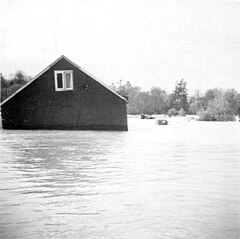Effects of Hurricane Hazel in Canada

This possibly floating house was transported a significant distance downstream by the Humber River (Ontario).
|
|
| Date | October 15–18, 1954 |
|---|---|
| Location | Ontario (especially Toronto) |
| Deaths | 81 total |
| Property damage | $125.2 million |
The effects of Hurricane Hazel in Canada included 81 deaths and C$137,552,400 ($1,126,947,163 in 2009) in damages. Hazel, the deadliest and costliest storm of the 1954 Atlantic hurricane season, reached Toronto, Ontario by the evening of October 15, 1954. It peaked as a category 4 storm, but by the time it reached Canada, it was an extratropical category 1 storm after merging with an existing cold front south of Ontario. Due to an area of high pressure to the north-east, Hazel stalled over Toronto and lost most of its moisture.
The worst-affected areas were communities near the Humber River, Holland Marsh, and Etobicoke Creek. Prone to flooding, the Humber River raced downstream from Woodbridge when an earthen dam failed. In the weeks prior to Hazel, Toronto had received copious amounts of rain, and the soil could not hold as much as 200 mm (7.9 in) of rain; consequently, over 90% of it went into Toronto's waterways. The Humber heavily flooded Weston, and killed 35 people in Raymore Drive. Holland Marsh was severely flooded; while no one was killed, the economic losses were severe as the region's crops were harvested but not collected. In the neighbourhood of Long Branch, the Etobicoke Creek killed seven people and swept numerous dwellings into Lake Ontario. Toronto's infrastructure also took a major hit, with as much as 50 bridges being washed out by the rising waters.
The situation was exacerbated by the lack of preparedness and awareness. Torontonians did not have prior experience with hurricanes, and the storm as whole proved to be extremely unpredictable—even the arrival of Hazel came as a surprise. Also, the low-lying areas near the Humber were mostly residential, which were among the worst-affected during the storm. In fact, following Hazel, residential development in areas along Toronto waterways was prohibited, and they became parks instead.
To help with the cleanup, the army was summoned. Due to the destruction in Canada, as well as the United States and Haiti, the name Hazel was retired, and will never again be used for an Atlantic hurricane. Since it was retired before the creation of formal lists, it was not replaced with any particular name.
...
Wikipedia
